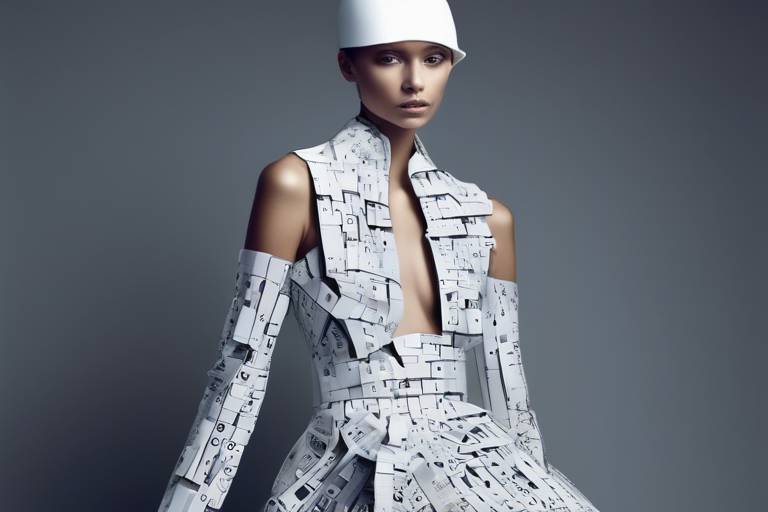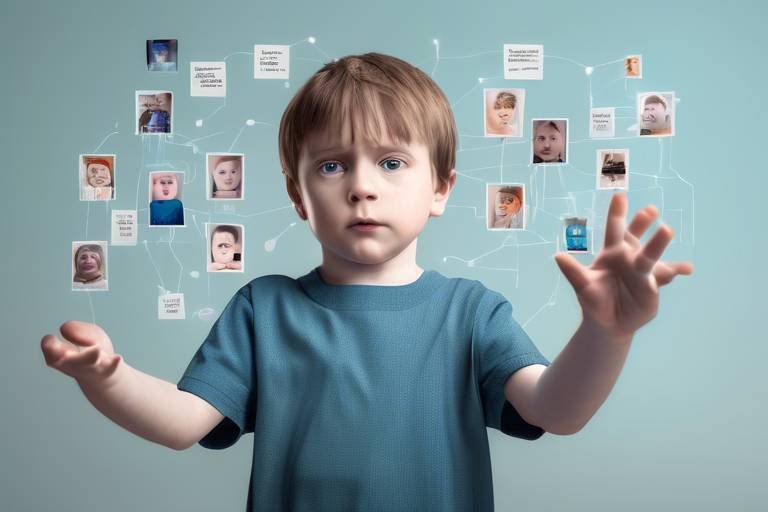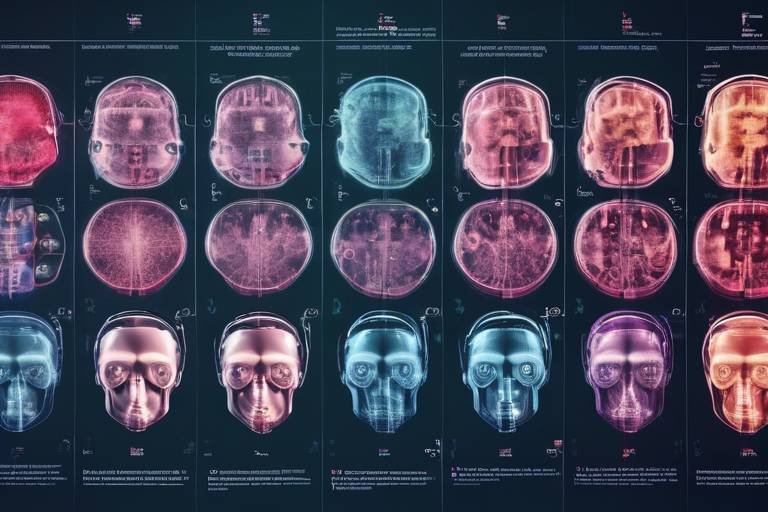AI and Modern Fashion: A Marriage of Creativity and Technology
In the ever-evolving world of fashion, the fusion of artificial intelligence (AI) with creative design is nothing short of revolutionary. Imagine a world where fashion designers are not just artists but also tech-savvy innovators, leveraging the power of AI to bring their visions to life. This intersection of technology and creativity is reshaping how we think about fashion, from the initial design process to the final consumer experience. With AI, designers can explore new horizons, enabling them to push boundaries and create garments that were once thought impossible.
The fashion industry, traditionally known for its reliance on human intuition and creativity, is now embracing algorithms and data analytics. This integration is not merely a trend; it's a transformation that enhances creativity while streamlining production processes. Designers can now experiment with styles and concepts in ways that were unimaginable just a few years ago. Imagine being able to visualize a collection before a single piece is sewn, or using AI to predict which colors will dominate the next season. This is the new reality.
Moreover, the consumer experience is also being revolutionized. With AI, brands can offer personalized shopping experiences that cater to individual tastes and preferences. Consumers are no longer just passive recipients of fashion; they are active participants in a dynamic and interactive process. As we delve deeper into this article, we will explore how AI is not only enhancing creativity in design but also personalizing the shopping experience and promoting sustainability within the fashion industry.
As we embark on this journey, let’s keep in mind the profound impact that AI is having on modern fashion. It’s not just about creating clothes; it’s about creating experiences, fostering sustainability, and redefining what it means to be fashionable in the digital age. So, buckle up as we explore the exciting world where creativity meets technology!

The Role of AI in Fashion Design
Artificial Intelligence (AI) is not just a buzzword; it’s a game changer in the world of fashion design. Imagine a world where designers can unleash their creativity without the traditional constraints of time and resources. AI provides a plethora of tools that enhance creativity, streamline processes, and enable designers to experiment with new styles and concepts in ways that were previously unimaginable. For instance, AI algorithms can analyze vast amounts of data to predict trends, allowing designers to create collections that resonate with current consumer preferences. This integration of technology into the design process is akin to having a personal assistant who not only understands your vision but also brings insights that can elevate your work to new heights.
Moreover, AI empowers designers to break free from conventional design methods. By utilizing machine learning, designers can generate unique patterns and styles that reflect emerging trends. Consider the way AI can analyze social media feeds and fashion blogs to identify what styles are gaining traction. This capability allows designers to stay ahead of the curve, ensuring that their creations are not only innovative but also relevant. It's like having a crystal ball that reveals the future of fashion, enabling designers to create pieces that are not just beautiful but also in demand.
Another fascinating aspect of AI in fashion design is its ability to automate repetitive tasks. Designers often spend a significant amount of time on mundane tasks such as sketching and fabric selection. AI can assist with these tasks, allowing designers to focus more on the creative aspects of their work. For example, AI-driven software can suggest fabric combinations based on the designer's previous work, or even create initial sketches based on a few input parameters. This not only speeds up the design process but also opens the door for experimentation and creativity.
In addition to enhancing creativity, AI also plays a pivotal role in collaboration. Designers can work with AI systems that facilitate communication and idea sharing among teams, regardless of their geographical locations. This collaborative approach can lead to a fusion of ideas that enriches the design process. As a result, the final products are often a reflection of diverse influences, making them more appealing to a broader audience.
To summarize, the role of AI in fashion design is transformative. It’s not just about improving efficiency; it’s about redefining creativity. The marriage of technology and artistry is paving the way for a new era in fashion where imagination knows no bounds. As we look to the future, one can only wonder how far this integration will take us. Will we see AI-generated fashion shows? Or perhaps virtual reality experiences where consumers can interact with designs before they hit the market? The possibilities are endless, and that’s what makes this intersection of AI and fashion so incredibly exciting.

Personalization through AI
In today's fast-paced world, personalization has become a key factor in enhancing the shopping experience, especially in the fashion industry. Thanks to the power of artificial intelligence, brands are now able to create a shopping experience that feels tailor-made for each individual customer. Imagine walking into a store where everything seems to be curated just for you—that's the magic AI brings to online and offline shopping alike.
AI analyzes vast amounts of consumer data to understand preferences, styles, and behaviors. This data-driven approach allows fashion retailers to recommend outfits that not only match current trends but also resonate with the unique tastes of each shopper. For instance, if a customer frequently browses bohemian-style clothing, AI algorithms will prioritize similar styles in their recommendations, making the shopping experience feel more intuitive and less overwhelming.
Moreover, the beauty of AI lies in its ability to learn and adapt. As customers interact with the platform, AI systems continuously refine their understanding of individual preferences. This means that over time, the recommendations become increasingly accurate and personalized. Imagine a personal stylist who knows you so well that they can predict what you’ll love next—this is what AI aims to achieve.
One of the most exciting aspects of AI-driven personalization is the potential for dynamic fashion suggestions. For example, a customer might receive real-time notifications about new arrivals that match their style or even alerts for sales on items they’ve shown interest in. This level of engagement not only boosts customer satisfaction but also drives sales, as shoppers are more likely to purchase items that feel personally relevant to them.
But it doesn’t stop there. AI can also analyze social media trends and influencer styles to keep brands ahead of the curve. By understanding what’s trending in real-time, companies can adjust their inventory and marketing strategies to align with consumer interests. This responsiveness is crucial in a world where fashion trends can change overnight.
In addition, AI's ability to integrate feedback from customers offers another layer of personalization. When consumers provide feedback on their purchases—whether through reviews, ratings, or social media posts—AI can analyze this data to further refine its recommendations. For instance, if a customer rates a particular dress highly, AI can suggest similar dresses or accessories that complement their favorite items, creating a seamless shopping experience.
The impact of AI on personalization is profound, and as technology continues to evolve, we can expect even more innovative solutions to emerge. With AI, the future of fashion shopping is not just about finding clothes; it’s about discovering a style that feels uniquely yours. As we embrace this new era, the lines between technology and creativity will blur, leading to a fashion landscape that is as diverse and dynamic as the consumers it serves.
- What is AI personalization in fashion?
AI personalization in fashion refers to the use of artificial intelligence to tailor shopping experiences to individual customers based on their preferences, behaviors, and past interactions. - How does AI analyze consumer preferences?
AI analyzes consumer preferences by collecting and processing data from various sources, including purchase history, browsing behavior, and social media interactions. - Can AI improve my shopping experience?
Absolutely! AI can enhance your shopping experience by providing personalized recommendations, helping you find items that match your style, and notifying you about relevant sales and promotions.

Data-Driven Insights
In today's fast-paced fashion landscape, understanding consumer preferences is more critical than ever. This is where come into play, acting as a compass that guides brands in their creative journey. By harnessing the power of artificial intelligence, fashion companies can delve deep into the vast ocean of customer data, extracting valuable insights that inform their design choices and marketing strategies. Imagine having a crystal ball that reveals what styles are trending or what colors consumers are gravitating towards—this is the magic of AI.
Fashion brands can analyze a multitude of data points, including purchase history, browsing behavior, and social media interactions, to paint a comprehensive picture of consumer desires. For instance, if a brand notices a spike in searches for sustainable clothing, they can pivot their design efforts to create more eco-friendly options. This not only aligns with consumer demand but also positions the brand as a leader in sustainability—a win-win situation!
Moreover, the integration of AI in data analytics enables brands to segment their audiences more effectively. By categorizing consumers based on their preferences, brands can tailor their marketing campaigns to resonate with different demographics. For example, a luxury brand might target fashion-forward millennials with bold, innovative designs, while appealing to a more classic audience with timeless styles. This level of personalization enhances customer engagement and drives sales.
To illustrate the impact of data-driven insights, consider the following table that highlights key metrics fashion brands can analyze:
| Data Metric | Importance |
|---|---|
| Purchase History | Identifies popular items and seasonal trends. |
| Browsing Behavior | Reveals consumer interests and potential buying patterns. |
| Social Media Engagement | Measures brand sentiment and emerging fashion trends. |
| Customer Feedback | Provides direct insights into consumer satisfaction and areas for improvement. |
In addition to these metrics, AI can also facilitate predictive modeling, which allows brands to forecast future trends based on historical data. This proactive approach helps companies stay ahead of the competition, ensuring they deliver what consumers want before they even know they want it. It’s like having a fashion oracle at your fingertips!
Lastly, by integrating customer feedback into their data analysis, brands can create a feedback loop that continuously informs their design and marketing strategies. Real-time feedback mechanisms, powered by AI, allow companies to adapt quickly to changing consumer sentiments. This responsiveness not only enhances brand loyalty but also fosters a sense of community among consumers, who feel their voices are being heard.
In conclusion, data-driven insights are revolutionizing the fashion industry by providing brands with the tools to understand and anticipate consumer needs. As AI technology continues to evolve, the potential for deeper insights and more personalized experiences will only grow, leading to a fashion landscape that is not only innovative but also deeply connected to the desires of its consumers.
- What are data-driven insights in fashion? Data-driven insights refer to the analysis of consumer data to understand preferences, trends, and behaviors that inform design and marketing strategies.
- How does AI help in fashion? AI helps fashion brands analyze large sets of data, predict trends, personalize shopping experiences, and streamline supply chains, ultimately enhancing creativity and efficiency.
- Can AI predict fashion trends? Yes, AI can analyze historical data and current consumer behavior to forecast future trends, allowing brands to stay ahead in the competitive fashion market.

Predictive Analytics
Predictive analytics is a game changer in the fashion industry, acting as a crystal ball for brands looking to stay ahead of the competition. By analyzing historical data and current trends, AI can forecast future consumer behavior with remarkable accuracy. Imagine being able to predict what styles will be hot next season or which colors will dominate the market! This capability allows brands to make informed decisions about their collections, ensuring they meet consumer demand before it even peaks.
At its core, predictive analytics uses complex algorithms and machine learning models to sift through vast amounts of data. This data can include everything from past sales figures and social media trends to customer reviews and even weather patterns. For instance, if a particular style of jacket sold exceptionally well during a cold winter last year, predictive analytics can suggest that a similar style might perform well again when temperatures drop. This not only helps brands optimize their inventory but also reduces the risk of overproduction and waste—a significant concern in today’s environmentally conscious market.
Furthermore, predictive analytics can enhance marketing strategies by identifying the right audience for each product. By segmenting consumers based on their buying habits and preferences, brands can tailor their marketing campaigns, ensuring that the right message reaches the right people at the right time. This targeted approach not only increases the likelihood of sales but also fosters a deeper connection between brands and their customers. For example, if data indicates that a specific demographic is increasingly interested in sustainable fashion, brands can focus their efforts on promoting eco-friendly collections to that audience, maximizing engagement and sales potential.
In addition to improving sales forecasts and marketing strategies, predictive analytics can also streamline the design process. Designers can use insights derived from predictive models to create collections that resonate with consumers, minimizing the risk of launching products that may not perform well in the market. By aligning design choices with data-driven insights, brands can foster a culture of innovation while remaining responsive to consumer needs.
Ultimately, the integration of predictive analytics into the fashion industry is not just about numbers; it's about understanding the heartbeat of the consumer. As brands embrace this technology, they can create more relevant and timely products, enhancing customer satisfaction and loyalty. The marriage of creativity and data science is paving the way for a future where fashion is not only stylish but also smart.
- What is predictive analytics in fashion? Predictive analytics in fashion involves using data analysis and machine learning to forecast future trends and consumer behavior, helping brands make informed decisions about design and inventory.
- How does predictive analytics benefit fashion brands? It helps brands optimize inventory, tailor marketing strategies, and streamline the design process, ultimately leading to increased sales and customer satisfaction.
- Can predictive analytics reduce waste in fashion? Yes, by accurately forecasting demand, brands can minimize overproduction and reduce waste, contributing to a more sustainable fashion industry.

Customer Feedback Integration
In today's fast-paced fashion world, understanding what the customer wants is paramount. AI systems have emerged as a game-changer in integrating customer feedback into the fashion design and production process. By leveraging advanced algorithms, brands can gather insights from various sources, including social media, online reviews, and direct surveys, allowing them to adapt their offerings swiftly based on real-time consumer input.
Imagine walking into a store where every piece of clothing is tailored to your taste. That's the power of AI in action! By analyzing customer feedback, brands can identify patterns and preferences, ensuring that their collections resonate with their target audience. For instance, if a particular style or color receives overwhelming positive feedback, designers can prioritize those elements in their upcoming lines. This not only enhances customer satisfaction but also fosters a sense of loyalty, as consumers feel heard and valued.
Moreover, AI-driven feedback integration allows brands to respond to negative feedback proactively. Instead of waiting for a customer to return a product, companies can analyze the data and make adjustments before the item hits the shelves. This not only reduces returns but also saves brands from potential PR disasters. The integration of customer feedback into the design process is akin to having a conversation with your best friend about what looks good on you; it’s all about collaboration and understanding.
To illustrate the effectiveness of customer feedback integration, consider the following table that highlights the key benefits:
| Benefit | Description |
|---|---|
| Enhanced Product Development | Direct insights from consumers help in creating products that meet actual market demands. |
| Increased Customer Loyalty | When customers see their feedback reflected in products, they are more likely to return. |
| Reduced Returns | Proactively addressing issues based on feedback minimizes the likelihood of returns. |
| Better Trend Forecasting | Real-time data allows brands to stay ahead of fashion trends and consumer preferences. |
In conclusion, the integration of customer feedback through AI is not just a trend; it’s a fundamental shift in how fashion brands operate. By embracing this technology, brands can create a more engaging and responsive shopping experience, ensuring that they not only meet but exceed consumer expectations. The future of fashion lies in collaboration between technology and creativity, and customer feedback is at the heart of this exciting evolution.
- How does AI gather customer feedback? AI systems analyze data from various sources, including social media, reviews, and direct surveys, to gain insights into customer preferences.
- Can AI help reduce product returns? Yes, by analyzing feedback and making adjustments before products are released, brands can significantly reduce the likelihood of returns.
- What role does customer feedback play in product development? Customer feedback provides direct insights that inform design choices, ensuring products align with consumer desires.
- Is customer feedback integration common in the fashion industry? While it's becoming more common, many brands are still in the early stages of fully leveraging AI for feedback integration.

Virtual Try-Ons and Augmented Reality
Imagine stepping into a world where you can try on clothes without ever leaving your home. This is the magic of virtual try-ons and augmented reality (AR). These technologies are not just gimmicks; they are transforming the way we shop for fashion, making it more engaging and personalized. With virtual try-ons, consumers can see how different outfits look on them in real-time, which is a game-changer for online shopping. No longer do you have to rely on size charts or guesswork—now you can visually experience how a garment fits and flatters your body shape before making a purchase.
One of the most exciting aspects of virtual try-ons is the use of AR technology, which overlays digital images onto the real world. When you use your smartphone or a dedicated device, you can see yourself wearing various styles, colors, and patterns without ever stepping into a fitting room. This not only enhances the shopping experience but also reduces the number of returns, as customers can make more informed decisions about their purchases. In fact, studies show that retailers who implement virtual try-on solutions can see a significant decrease in return rates, which is a win-win for both consumers and brands.
Moreover, virtual try-ons can be integrated with social media platforms, allowing users to share their looks with friends and family before committing to a purchase. This social aspect adds a layer of fun and excitement to online shopping, making it feel more like a communal experience rather than a solitary task. Imagine posting a picture of yourself in a new dress and getting instant feedback from your friends—this interaction can influence buying decisions and enhance customer satisfaction.
To further illustrate the impact of virtual try-ons and augmented reality, consider the following table showcasing the benefits:
| Benefit | Description |
|---|---|
| Enhanced Shopping Experience | Allows customers to visualize outfits on themselves, making shopping more interactive. |
| Reduced Return Rates | Helps customers make informed choices, leading to fewer returns and exchanges. |
| Social Sharing | Encourages users to share their virtual looks on social media for feedback. |
| Increased Engagement | Creates a fun and engaging shopping experience that keeps customers coming back. |
In conclusion, the combination of virtual try-ons and augmented reality is not just a passing trend; it represents a significant shift in how we interact with fashion. As technology continues to advance, we can expect even more innovative solutions that will further enhance our shopping experiences. So, the next time you're browsing online for a new outfit, imagine being able to try it on virtually—it's not just a dream anymore; it's the future of fashion!
- What is virtual try-on technology? Virtual try-on technology allows consumers to see how clothing looks on them through augmented reality, enhancing the online shopping experience.
- How does augmented reality improve shopping? Augmented reality overlays digital images onto the real world, enabling users to visualize how clothes fit and look before purchasing.
- Can virtual try-ons reduce returns? Yes, by allowing customers to make informed decisions about their purchases, virtual try-ons can significantly decrease return rates.
- Is virtual try-on technology widely available? Many fashion retailers are adopting this technology, making it increasingly accessible to consumers.

Sustainable Fashion and AI
In an era where environmental consciousness is at an all-time high, the fashion industry is stepping up to the plate, and artificial intelligence (AI) is leading the charge towards sustainability. The intersection of AI and sustainable fashion is not just a fleeting trend; it's a profound shift that promises to redefine how we create, produce, and consume clothing. Imagine a world where every garment is crafted with precision, minimizing waste and maximizing efficiency. This is not just a dream—it's becoming a reality thanks to AI.
One of the most significant contributions of AI to sustainable fashion is its ability to optimize production processes. By analyzing vast amounts of data, AI algorithms can predict consumer demand more accurately. This means that brands can produce just the right amount of clothing, reducing the overproduction that often leads to unsold inventory and ultimately, waste. In fact, studies have shown that overproduction is responsible for a staggering percentage of the fashion industry's environmental footprint. With AI, brands can align their production with actual consumer demand, ensuring that every piece of clothing has a purpose.
Additionally, AI plays a crucial role in material innovation. Research and development powered by AI are paving the way for the creation of sustainable materials that are not only environmentally friendly but also high-quality alternatives to traditional fabrics. For instance, AI can assist in the development of biodegradable textiles or fabrics made from recycled materials. This innovation is essential in reducing the environmental impact of the fashion industry, which is notorious for its reliance on non-renewable resources.
Moreover, AI enhances supply chain efficiency, a critical component of sustainable fashion. By utilizing predictive analytics, brands can optimize their inventory levels, ensuring that they have just enough stock to meet consumer demand without excess. This not only minimizes waste but also helps in reducing the carbon footprint associated with transportation and storage. The table below illustrates the impact of AI on supply chain management:
| AI Application | Impact on Supply Chain |
|---|---|
| Demand Forecasting | Reduces overproduction and waste |
| Inventory Optimization | Minimizes excess stock and storage costs |
| Resource Management | Enhances efficiency in material usage |
As we look to the future, it's clear that the integration of AI in sustainable fashion is not just beneficial—it's essential. The fashion industry is notorious for its environmental challenges, from excessive water usage to the generation of textile waste. However, with AI's capabilities, brands are now equipped to tackle these issues head-on. By embracing technology, the fashion world can move towards a more sustainable model that not only benefits the planet but also resonates with increasingly eco-conscious consumers.
In conclusion, the marriage of AI and sustainable fashion is a promising development that holds the potential to revolutionize the industry. As we continue to innovate and adapt, the prospect of a greener, more responsible fashion landscape is within reach. So, the next time you slip into a new outfit, remember that behind the seams, AI might just be working tirelessly to ensure that your fashion choices are as sustainable as they are stylish.
- How does AI help in reducing waste in the fashion industry?
AI analyzes data to predict consumer demand accurately, allowing brands to produce only what is needed, thus minimizing overproduction and waste. - What are some examples of sustainable materials developed using AI?
AI is helping create biodegradable textiles and fabrics made from recycled materials, which are environmentally friendly alternatives to traditional fabrics. - Can AI improve supply chain efficiency in fashion?
Yes, AI optimizes inventory levels and enhances resource management, leading to improved supply chain efficiency and reduced environmental impact.

Supply Chain Optimization
In the fast-paced world of fashion, the supply chain is the backbone that supports every design, production, and distribution effort. With the integration of artificial intelligence, brands are experiencing a revolutionary shift in how they manage their supply chains. Imagine a system that not only predicts what styles will be popular but also ensures that the right amount of inventory is produced at the right time. This is not just a dream; it’s the reality brought forth by AI.
AI algorithms analyze vast amounts of data, from past sales trends to current consumer behavior, allowing brands to anticipate demand with remarkable accuracy. This means that instead of overproducing and risking excess inventory, companies can create just enough to meet consumer needs. The result? Less waste and a more sustainable approach to fashion. For example, a leading fashion brand recently reported a 30% reduction in unsold inventory after implementing AI-driven demand forecasting.
Moreover, AI enhances inventory management by optimizing stock levels across various locations. This is where the concept of just-in-time inventory comes into play. By ensuring that materials and products are available only when needed, brands can cut down on storage costs and minimize the risk of obsolescence. Imagine a scenario where a trendy new fabric is just a click away, ready to be delivered to a designer's studio without the hassle of overstocking. This seamless integration not only increases efficiency but also allows for a quicker turnaround from design to retail.
Additionally, AI can streamline logistics by analyzing routes and delivery times, ensuring that products reach consumers faster and more efficiently. This is crucial in a market where speed can make or break a brand's reputation. For instance, AI systems can predict the best shipping methods and routes, reducing delivery times by up to 25% while also cutting costs. This optimization not only satisfies consumer demand for quick delivery but also supports the brand's bottom line.
To illustrate the impact of AI on supply chain optimization, consider the following table:
| AI Application | Benefit |
|---|---|
| Demand Forecasting | Reduces excess inventory and waste |
| Inventory Management | Optimizes stock levels and reduces costs |
| Logistics Optimization | Improves delivery speed and efficiency |
In conclusion, the integration of AI into supply chain management is not merely a trend; it is a fundamental shift that is reshaping the fashion industry. Brands that embrace these technologies will not only enhance their operational efficiencies but also contribute to a more sustainable future. As we move forward, the question remains: how will your favorite fashion brands adapt to these changes? The answer lies in their willingness to innovate and leverage the power of AI.
- How does AI improve supply chain efficiency?
AI improves supply chain efficiency by predicting demand, optimizing inventory levels, and enhancing logistics, thus reducing costs and waste.
- What are the benefits of just-in-time inventory?
Just-in-time inventory reduces storage costs, minimizes the risk of obsolescence, and ensures products are available when needed.
- Can AI help in sustainability efforts in fashion?
Yes, AI promotes sustainability by optimizing production processes, reducing waste, and enabling brands to make data-driven decisions that align with consumer demand.

Material Innovation
In the ever-evolving world of fashion, is at the forefront of driving change and sustainability. As the industry grapples with the environmental impacts of traditional textile production, innovative materials are emerging as a beacon of hope. These new fabrics not only aim to reduce the carbon footprint but also enhance the overall quality and functionality of garments.
One of the most exciting advancements in material innovation is the development of biodegradable fabrics. Unlike conventional textiles that can take centuries to decompose, these eco-friendly alternatives break down naturally, significantly reducing landfill waste. For instance, brands are now experimenting with fabrics made from organic cotton, hemp, and even recycled materials. This shift not only addresses environmental concerns but also caters to the growing consumer demand for sustainable fashion.
Another fascinating area is the rise of smart textiles. These materials incorporate technology directly into the fabric, allowing garments to interact with the wearer and the environment. Imagine a shirt that can change color based on temperature or a pair of pants that can monitor your activity levels. Such innovations are not just futuristic dreams; they are becoming a reality, thanks to advancements in material science and artificial intelligence.
Additionally, the integration of AI in the research and development of new materials has led to the creation of high-performance fabrics that offer enhanced durability, breathability, and comfort. For example, brands are utilizing AI algorithms to analyze the properties of various fibers, leading to the discovery of unique combinations that yield superior results. This process not only speeds up the development cycle but also ensures that the materials meet the specific needs of consumers.
To illustrate the impact of these innovations, consider the following table showcasing some of the groundbreaking materials being utilized in modern fashion:
| Material | Characteristics | Environmental Impact |
|---|---|---|
| Organic Cotton | Soft, breathable, and biodegradable | Lower water usage and no harmful pesticides |
| Recycled Polyester | Durable, moisture-wicking, and versatile | Reduces plastic waste and energy consumption |
| Hemp | Strong, UV resistant, and naturally pest-resistant | Minimal water and chemical use, fast-growing |
| Bio-fabricated Materials | Innovative, versatile, and customizable | Reduces reliance on fossil fuels and traditional agriculture |
As we look to the future, the potential for material innovation in fashion is limitless. With the combined forces of creativity and technology, designers are not only reimagining what clothing can be but also how it can be produced. This harmonious blend of sustainability and innovation is paving the way for a more responsible fashion industry, where every piece of clothing tells a story of environmental consciousness and cutting-edge design.
- What are biodegradable fabrics? Biodegradable fabrics are textiles that can decompose naturally, reducing environmental waste.
- How do smart textiles work? Smart textiles are embedded with technology that allows them to react to environmental changes or user interactions.
- Why is material innovation important in fashion? Material innovation is crucial for creating sustainable alternatives to traditional textiles, reducing the industry's environmental impact.
- What role does AI play in material development? AI assists in analyzing fiber properties and discovering new material combinations, speeding up the innovation process.

The Future of Fashion with AI
The future of fashion is not just a dream; it is unfolding before our very eyes, and at the heart of this transformation lies artificial intelligence. As we look ahead, it's clear that AI will not only enhance creativity but also redefine the entire fashion landscape. Imagine a world where your wardrobe is perfectly curated, where designers can effortlessly bring their visions to life, and where sustainability is at the forefront of every clothing line. This is the exciting future that AI is paving the way for.
One of the most significant changes we can anticipate is the rise of hyper-personalization. As AI algorithms become more sophisticated, they will analyze not just buying patterns but also emotional responses to styles. This means that fashion brands will be able to create collections that resonate deeply with consumers on a personal level. Picture this: you walk into a store, and the clothes displayed are all tailored to your unique taste and style preferences. It's like having a personal stylist at your fingertips!
Moreover, the integration of AI in design processes will allow for rapid prototyping and iteration. Designers will be able to experiment with countless variations of a single piece in a fraction of the time it takes today. This not only boosts creativity but also enhances efficiency. Imagine a designer who can visualize their ideas in real-time, adjusting colors, patterns, and styles instantly. This level of innovation could lead to entirely new fashion trends emerging at lightning speed.
Another thrilling aspect of AI’s future in fashion is its potential to enhance sustainability. With growing concerns about the environmental impact of the fashion industry, AI can help brands make informed decisions that prioritize eco-friendliness. For instance, AI can optimize production schedules to reduce waste or suggest alternative materials that have a lower environmental footprint. The future could see a fashion industry where every piece of clothing is not only stylish but also ethically produced.
As we embrace this AI-driven future, we must also consider the implications for the consumer experience. The shopping journey will become increasingly immersive, with technologies like virtual reality and augmented reality transforming how we interact with fashion. Imagine trying on clothes without ever stepping into a fitting room, or attending a virtual fashion show where you can see the latest collections from the comfort of your home. This seamless integration of technology into fashion will create a more engaging and enjoyable shopping experience.
However, as we move forward, it’s essential to strike a balance between technological advancement and the human touch. While AI can offer incredible insights and efficiencies, the essence of fashion lies in creativity, emotion, and personal expression. The future of fashion with AI will be most successful when it embraces both technology and the artistry of human designers, creating a harmonious relationship that celebrates innovation while honoring tradition.
- How will AI impact the fashion design process?
AI will streamline design processes, allowing for rapid prototyping and creative experimentation. - Can AI help in creating sustainable fashion?
Yes, AI can optimize production and supply chains to reduce waste and suggest sustainable materials. - What role will personalization play in the future of fashion?
AI will enable hyper-personalization, offering consumers tailored shopping experiences based on their preferences. - Will technology replace human designers?
No, technology will enhance the creative process, allowing designers to focus on innovation while AI handles data analysis.
Frequently Asked Questions
- How is AI transforming fashion design?
AI is revolutionizing fashion design by providing tools that enhance creativity. Designers can now experiment with new styles and concepts in ways that were previously unimaginable. With AI, the creative process is streamlined, allowing for quicker iterations and more innovative designs.
- What role does personalization play in AI-driven fashion?
Personalization is a game-changer in AI-driven fashion. By analyzing consumer data, AI can recommend outfits tailored to individual preferences. This not only enhances the shopping experience but also helps brands connect more deeply with their customers by understanding their unique styles and needs.
- How do data-driven insights benefit fashion brands?
Fashion brands leverage AI to analyze customer data, gaining valuable insights into trends and preferences. This information informs design choices and marketing strategies, ensuring that brands align their offerings with consumer demand and stay relevant in a fast-paced industry.
- What is predictive analytics in the fashion industry?
Predictive analytics powered by AI helps fashion brands forecast trends and consumer behavior. This allows brands to make informed decisions about future collections, ensuring they stay ahead of the curve and cater to what consumers will want next.
- How does AI enhance the online shopping experience?
With advancements in augmented reality, AI enables virtual try-ons, allowing consumers to see how clothing looks on them before making a purchase. This interactive experience not only boosts customer confidence but also reduces the likelihood of returns, benefiting both consumers and retailers.
- In what ways is AI promoting sustainable fashion?
AI promotes sustainability by optimizing production processes and reducing waste. By predicting demand and optimizing inventory levels, AI contributes to a more sustainable fashion ecosystem, helping brands minimize their environmental impact.
- What innovations in materials are being driven by AI?
Research and development in AI are leading to the creation of innovative, sustainable materials. These new fabrics not only reduce environmental impact but also offer high-quality alternatives to traditional fabrics, paving the way for a greener fashion industry.
- What does the future hold for AI in fashion?
The future of fashion with AI promises exciting advancements. As technology continues to evolve, we can expect a harmonious coexistence of creativity and technology, leading to more innovative designs, personalized shopping experiences, and sustainable practices in the fashion industry.



















